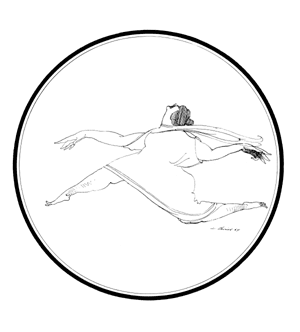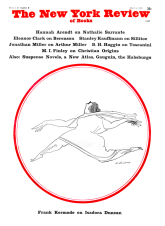Everybody knows something about Isadora Duncan, but it is usually gossip rather than history. She undoubtedly has some degree of genuine historical importance; modern dancers honor her for her service in the development of their art, and she was internationally famous at a time when dancing ceased to be an entertainment and became in the minds of many the key to all the arts A serious inquiry into the real nature and quality of her work would involve a laborious historical investigation, but it would certainly be worth doing. Mr. Terry’s book is not as serious as that, and is in fact a little sentimental, deficient in documentation, scrappy, and gossipy; but it has some use and interest.
Mr. Terry of course, is not to be blamed for his subject’s highly colored life. She came of an odd family (in a passage of her autobiography not mentioned by Mr. Terry she attributes some of her eccentricities to the fact that her mother ate and drank nothing during pregnancy except oysters and champagne). Her lovers were at least interesting, and included Gordon Craig and Yesenin, the revolutionary poet, whom she actually married. Her extravagance was notorious, and she became one of those whose whole fate takes the color of her bizarre personality; her children were drowned in an auto accident, and she herself was strangled by her scarf when it caught in the rear wheel of a Bugatti All this, and the social career of one whose main business was to be outrageously free, Mr. Terry records. On her place in the whole history of exotic and “new” dancing at the time he has much less to say, though the book has some excellent photographs. As for Isadora’s theories, he chronicles them without much comment, and dreadful nonsense they are.
Duncan’s hatred for orthodox ballet was fairly standard in some circles at the time. Technically she was ill-equipped and undisciplined, and as time went on she made this worse by laziness, carelessness, and obesity. Balanchine, in an article here quoted, saw her in 1920, and found her “unbelievable—a drunken fat woman who for hours was rolling like a pig.” André Levinson, from whom Terry rather misleadingly extracts a favorable comment, thought both Isadora and the “Isadorables” insipid—elementary in technique, boring in their bogus “Hellenism,” and responsible for a European torrent of imitative large flat feet. In spite of these disadvantages, she more than held her own in St. Petersburg, and, which is more remarkable, succeeded in Paris in 1909, the year of Diaghilev’s arrival there. Diaghilev supports the tradition that Fokine was much affected by her; so, according to testimony provided by Terry, was Sir Frederick Ashton, who says it shows in Ondine. So she has her place in ballet as well as in modern dance.
Some of the evidence for her originality is questionable. Mr. Terry twice rejects suggestions that Duncan owed a lot to Loïe Fuller, yet many of the compliments paid her had seen service fifteen years before when Fuller first went to Paris. Fuller’s was the stronger appeal to artists; and it was she who began the practices of using highbrow music, as Duncan did—in fact, she commissioned works from Debussy and Florent Schmitt. Neither was very original in dance theory, but Fuller was incomparably more resourceful in the theater. Duncan’s theory seems to contain some watery theosophy, very voguish then, about the solar plexus as power-center, etc. Her Hellenism was already old hat, and so was her virtually Rousseauistic naturalism. The union of the arts of poetry, music and dance was the commonplace dream of the previous generation; appropriately, Isadora went to Bayreuth and danced in Tannhauser. Even her insistence on dancing as a religion was Ninetyish.
Why was she so much admired? In part, maybe, because she satisfied certain expectations so fully—all those floating notions which had attached themselves to the early Fuller now alighted on Duncan. There was one thing that was new—the sense of liberation her dances gave, as noted by Rodin (also a great admirer of Fuller’s, incidentally). This must have had something to do with the freedom and transparency of her costume; and perhaps also with the low state of ballet at the Opéra. The visibility of Isadora piquantly endorsed her amorous reputation, and even, perhaps, her later fame as a Bolshevik. Somebody in Mr. Terry’s book calls her “the greatest courtesan of our times,” and somebody else, very absurdly, “a Colette who danced.” This reputation for being free in other respects reflected beneficially on her reputation as a free dancer.
No motion picture of Duncan survives, so far as I know. This may be a blessing. She was once beautiful and always wild; her body and its movements were graceful in the eyes of her contemporaries, as many drawings here reproduced can testify. She fostered the growth of a kind of dancing different from that of the ballet schools, but founded no school herself. It is hard to believe she had any intrinsic importance; but by a trick of history it turns out that she left a permanent mark on almost all the great dance movements of our time. Hence she is worth study; and Mr. Terry has done some of the work.
Advertisement
This Issue
March 5, 1964




